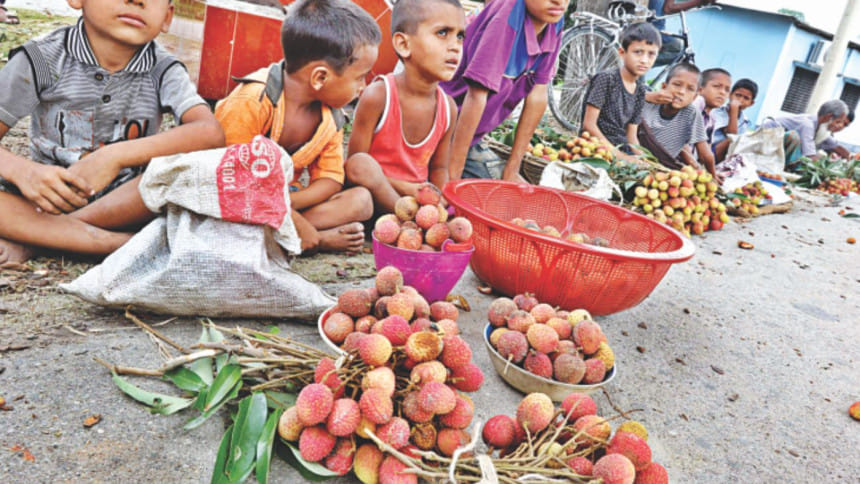Pesticide killed the 13 Dinajpur kids

A globally banned toxic pesticide caused an outbreak of acute encephalitis syndrome (AES), killing 13 children in Dinajpur in 2012, says a study published in the American Journal of Tropical Medicine and Hygiene on Monday.
AES is a condition often associated with deadly inflammation of the brain.
Scientists and researchers from International Center for Diarrheal Disease Research, Bangladesh (icddr,b), Institute of Epidemiology, Disease Control and Research (IEDCR) and the United States Centers for Disease Control and Prevention (CDC) came up with the finding after investigating 14 cases of AES reported in Dinajpur between May 31 and June 30 of 2012.
Of the 14 children, aged between one and 12, only one survived.
The journal says the scientists found that local growers were applying endosulfan in litchi orchards during the outbreak. It also notes endosulfan is a highly toxic insecticide that was banned in more than 80 countries due to its harmful health effects.
Till 2016, Bangladesh was one of the several countries, including the United States, which still allowed restricted use of endosulfan. The pesticide was slated to be phased out of use in the US by the end of that year.
Syed Nurul Alam, who heads the Entomology Division of Bangladesh Agricultural Research Institute, told The Daily Star yesterday that as far as his knowledge went, endosulfan was not being applied in crops anymore. However, it still remains as a registered pesticide in the country.
He said it should be banned immediately.
Contacted, Amitabh Das, director of Plant Protection at the Department of Agricultural Extension, however, claimed that endosulfan has not been imported in the country in the last three years.
He also rejected the journal's claim that the insecticide was in use in Bangladesh until last year.
However, an official of a multinational agro-input company operating in Bangladesh, said different brands were still marketing endosulfan, which ahas easy access to the country through the porous border with India, one of the few countries yet to ban the pesticide.
Deaths of all the 13 children in Dinajpur, which occurred within 20 hours of the onset of AES symptoms, were linked to exposure to litchis. Similar deaths from AES have been observed near litchi orchards in India, said a press release issued by the journal yesterday.
However, a recent analysis published in The Lancet, a medical journal, said the deaths in India were caused by a reaction to a naturally occurring toxin found in litchi seeds and pulp.
“Our investigation suggested the seeds might not be the cause as the seeds are not eaten in Bangladesh and instead found the deaths in 2012 were most likely due to an exposure to multiple, highly toxic agrochemicals,” said icddr,b Associate Scientist M Saiful Islam, also the lead author of the study published in the journal.
Talking to The Daily Star yesterday, Saiful said, "What we've learnt from the Dinajpur tragedy and our study is that Bangladesh needs to monitor applications of all sorts of toxic agrochemicals, stop overuse of pesticides and educate farmers about proper dosage."
A co-author and immediate-past director at IEDCR Mahmudur Rahman told The Daily Star that the Dinajpur incident was not the first such case.
"We found the role of pesticide toxins in the case of Dhamrai too when three children died and eight others became ill back in 2009. Then such incidents were also reported in Naogaon during 2007-08 and once again in Dinajpur in 2014."
According to the study published in the journal, 13 of the 14 children lived either right beside or within 10 metres of a litchi orchard. One victim did not live as close to an orchard, but, before becoming ill, he reportedly consumed a large number of litchis collected from the same orchards.
The outbreak occurred around harvest times, when there is typically an abundance of litchis on the ground around the trees.
Locals told the investigators that it was common for children to play in the orchards and eat fruits that had fallen on the ground without washing it, using their teeth to peel the litchi's skin.
In addition, several of the victims had family members who worked in the orchards, which, the study notes, could have increased exposures via residues on clothing worn into the home.
Several families of victims reported the symptoms began with a sharp, sudden cry from their children. Loss of consciousness occurred, on average, about two and a half hours after the onset of illness and deaths within about 20 hours or less.
Other symptoms included respiratory distress, froth at the mouth and convulsions.
While it is known that an infection like meningitis can lead to AES, the scientists asserted that the “short duration between onset of illness and death all suggest the outbreak was more likely due to a toxic poisoning than an infection.”
Lead author Saiful said physical evidence collected from the orchards, which included discarded containers of insecticides and other chemicals, and interviews with community residents suggested that multiple chemicals were applied to the fruit and in amounts far greater than are normally used by other litchi producers.
The study also found evidence that the litchi growers were applying an insecticide that had been approved only for use in cotton, not food crops.
“People in the communities told us that sometimes the spraying was so heavy it became difficult to stay in their houses and that the smell would linger for hours,” he said.
The researchers also noted that clinical symptoms seen in the children were similar to what was noted in an outbreak of sudden child deaths in 2009 in Bangladesh that was linked to the carbamate class of insecticides, which were also used in the litchi orchards.
Additionally, the study pointed to a 2015 outbreak in the same region that involved 12 recorded hospitalisations and 11 deaths as further evidence that the 2012 outbreak is likely associated with the use of toxic chemicals in the area.
“This study makes a strong case for the value of solid detective work and community engagement when investigating the causes of a dangerous and tragic public health crisis,” said Patricia F. Walker, president of the American Journal of Tropical Medicine and Hygiene.
“By working closely with the affected communities and earning their trust, researchers were able to identify the potential role of agricultural chemicals in this outbreak. Community education and improved oversight of pesticide use will be needed to help reduce the risk of future tragedies"
Published since 1921, the American Journal of Tropical Medicine and Hygiene is the peer-reviewed journal of the American Society of Tropical Medicine and Hygiene, founded in 1903, and the world's leading voice in the fields of tropical medicine and global health.


 For all latest news, follow The Daily Star's Google News channel.
For all latest news, follow The Daily Star's Google News channel. 



Comments